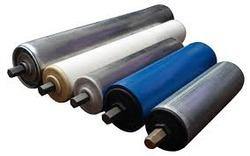

Owing to the vast industrial experience, we have been able to offer a wide array of Idler Rollers to our valuable customers. Manufactured in accordance with the industry set standards, these rollers are widely used in different constructional applications. Due to their optimum performance and minimum maintenance, these rollers are highly demanded in the market.
Solutions for lighweight materials to be transported
With this product range, you can set up roller conveyors for lightweight, small and, to some extent, medium-heavy materials to be transported, for example for paper in a printing machine, for bottles, small containers for the pharmaceutical or beverage industries or small cardboard boxes in the packaging industry weighing up to 35 kg and at conveyor speeds of up to 1.5 m/s. The load capacity of these products is up to 350 N per conveyor roller.
Conveyor Chain features a unique construction of cylindrical bearings inside the roller, which increases efficiency, lowers costs, suppresses stick- slip phenomenon, and extends roller and rail life compared to existing conveyor chains.A conveyor belt is the carrying medium of a belt conveyor system (often shortened to belt conveyor). A belt conveyor system is one of many types of conveyor systems. A belt conveyor system consists of two or more pulleys (sometimes referred to as drums), with an endless loop of carrying medium - the conveyor belt - that rotates about them. One or both of the pulleys are powered, moving the belt and the material on the belt forward. The powered pulley is called the drive pulley while the unpowered pulley is called the idler pulley. There are two main industrial classes of belt conveyors; Those in general material handling such as those moving boxes along inside a factory and bulk material handling such as those used to transport large volumes of resources and agricultural materials, such as grain, salt, coal, ore, sand, overburden and more.
Today there are different types of conveyor belts that have been created for conveying different kinds of material available in PVC and rubber materials.
The belt consists of one or more layers of material. Many belts in general material handling have two layers. An under layer of material to provide linear strength and shape called a carcass and an over layer called the cover. The carcass is often a woven fabric having a warp & weft. The most common carcass materials are polyester, nylon and cotton. The cover is often various rubber or plastic compounds specified by use of the belt. Covers can be made from more exotic materials for unusual applications such as silicone for heat or gum rubber when traction is essential.
Material flowing over the belt may be weighed in transit using a beltweigher. Belts with regularly spaced partitions, known as elevator belts, are used for transporting loose materials up steep inclines. Belt Conveyors are used in self-unloading bulk freighters and in live bottom trucks. Belt conveyor technology is also used in conveyor transport such as moving sidewalks or escalators, as well as on many manufacturing assembly lines. Stores often have conveyor belts at the check-out counter to move shopping items. Ski areas also use conveyor belts to transport skiers up the hill.
Incorporated in the year 1996, at Vadodara (Gujarat, India), we “Amarshiv Engineering Company” are instrumental in manufacturing, exporting and supplying a broad assortment of Material Handling Equipment. Our products range are Jaw Crusher, Stacking Hopper and Rotopactor Feeder.
More details:View company website
Its Free
Verify Now